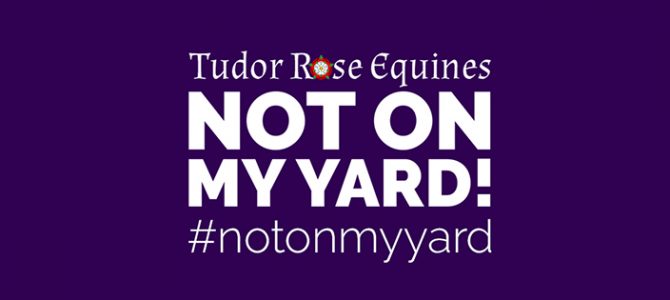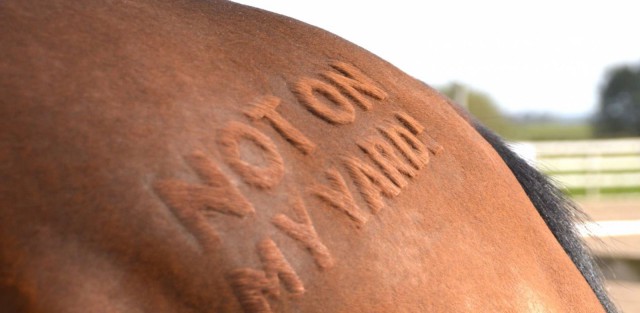In 2016 the Not On My Yard anti-bullying campaign was launched by Tudor Rose Equines in an effort to high light bullying within the equestrian industry. Having worked with children and young adults for over a decade, bullying and its effect on those involved has become a subject that is very close to my heart. The Not On My Yard campaign got me thinking – what support is offered to the equestrian community should you become aware of bullying within your establishment or organisation? Are there measures equestrian centers and clubs can take to discourage such bullying behavior and support those who are affected by it? Although written in context for Irish riding establishments, this article suggests some measures that any riding school and equestrian club can implement to prevent and discourage bullying behavior.
What is bullying?
Barnardos (an Irish charity for children’s welfare) provides an excellent resource to understand what constitutes bullying. They describe it as “..repeatedly harming someone – emotionally, physically or both.” What is important to remember is that bullying can occur in any social group and is not exclusive to children and teens. Susan Oaks, a world record holding Irish side saddle rider and supporter of the Not On My Yard campaign, bravely spoke out about her own experiences of bullying. Her story is a prime example of how bullying happens in every walk of life, no matter what age or how successful you are.
In my own experience bullying often begins with personality clashes, jealousy or external factors contributing to the bullying behavior. Unfortunately bullying can involve adult to adult, child to child and and sadly sometimes adult to child and even visa-versa. As equestrians we’ve all seen it at some point; jealousy within the livery yard, begrudgery when someone does well at a show, snobbery and judging others by something as irrelevant as what brand of jodhpurs they are wearing! I’ve personally witnessed an instructor make an inappropriate comment to a parent about their child’s pony purely on the basis of it’s colour and type. It is this type of culture that enables bullying to occur.
More often than not those who are involved in bullying are genuinely unaware of the affect their behavior is having on the other person involved. These situations are easily resolved with the guidance of a facilitator, such as a parent, teacher, coach or instructor. The most important thing to remember is that any type of bullying behavior regardless of age or status is wrong and unacceptable. It is ultimately our moral obligation as instructors and coaches to discourage and stop it. The following section will shed some light on the measures you can take and the resources that are out there to help you prevent bullying in your yard.
Know the law, your employees and your volunteers
Garda Vetting
Current Child Protection legislation in Ireland states that any party working with children and/or vulnerable adults must be vetted with the The National Vetting Bureau (Children and Vulnerable Persons Act 2012 to 2016). Horse Sport Ireland (HSI) is the national governing body for equestrian sport in Ireland. It’s affiliates include The Association for Irish Riding Clubs, The Irish Pony Club, Show Jumping Ireland, Dressage Ireland, Eventing Ireland and the Association of Irish Riding Establishments, or AIRE (aptly named as “aire” is the Irish word for care or attention!). Those employed or volunteering with any of these organisations should be vetted through HSI.
Although we all understand that the vetting process is a now a legal requirement, many people are still unclear as to how the vetting process works for them. Horse sport Ireland’s vetting policy covers the ‘”best practice in the recruitment and selection of persons to work with children and vulnerable adults in (i) HSI activities and (ii) membership/suitability to work within our Affiliates” (the full policy document is outlined here). Basically it’s a resource for employers/committees to determine the suitability of their employees/volunteers to work should they hold any previous convictions.
What I feel is not clearly explained is that each establishment is responsible for determining whether or not a person is a potential risk to the those within their care. Should an employee or volunteer have something on their record it is ultimately the employer who makes the decision whether or not they want that person working for them. In order to make these decisions easier, riding schools and club committees should have clear policies in place outlining what constitutes “misconduct” or “unacceptable” behavior to be employed in their school or volunteer for their club or organisation.
Furthermore, best practice states that vetting should be carried out every 5 years but again, each individual establishment can outline their own personal policy in regards to the frequency of vetting. For example, if you have seasonal staff or frequent changes in volunteers, you may want to vet them every 2 or 3 years or even every year. It is worth noting that “occasional” employees or volunteers, such as guest instructors, do not need to be vetted on the understanding that they do not work more than once in a month. Anyone working more than this should be vetted (for an in-depth description of “occasional work” please refer to the HSI policy document above).
Riding schools please note! If you have young helpers between the ages of 16 and 18 they must be vetted as a minor. Should a helper turn 18 after being vetted as a minor they must then be re-vetted as an adult!!
Child Protection
Along with Garda vetting procedures, all riding schools and clubs should have a child protection officer and know who their designated liaison officer is within their organisation. HSI offers the Safeguarding 1 – Basic Awareness Workshop in Child Welfare & Protection (mandatory for anyone working with children!). These courses are held at various venues around the country through out the year. The aims of these courses, as outlined on the HSI website, are as follows:
- To understand the rational behind the “Code of Ethics and Good Practice for Children’s Sport”
- To identify good practices when working with young people
- To create a better atmosphere that promotes positive adult-child relationships
- To identify the role of the Athlete, Coach, Parents/Guardians and Club
I understand it can be daunting thinking of the responsibility that comes with being a named child protection officer and that all this talk of Garda vetting and child protection can be overwhelming. I myself remember feeling overwhelmed when topics such as abuse or disclosures were discussed at my first child protection workshop – knowing that in the event of such an incident I’d be the first point of contact! However, what I have learned over the years that forewarned is forearmed and these workshops provide valuable insights into the types of incidents you may come across and more importantly, the correct procedures to take when dealing with them. Furthermore, the more information you have the better equipped you are to prevent bullying or abuse!
Adopting the Not On My Yard campaign
So what can you do to make your yard an anti-bullying centre? Well adopting the Not in My Yard campaign is a perfect basis to create an anti-bullying culture within your yard or organisation.
We know that bullying is any behaviour which effects the physical or emotional well-being of another person. Unfortunately both children and adults are often completely unaware of the effects their behavior has on another person. Name calling or “slagging” is all too often deemed “just a bit of messing” or “only having the craic.” The fact of the matter is that many children, and again adults too, are already exposed to things they shouldn’t be. We all know that the every day stresses of school, work and life in general are often forgotten the second we pull our boots on and head to the yard. So the last thing that anyone needs for the one place that they love and feel safe in, is for it to become a toxic environment.
I’m not suggesting we go out and tell all our clients to talk about their feelings as we try to teach them the rising trot or send them down a grid of jumps! But we do need to lead by example in order to create a positive and fun learning environment, as well as an environment in which people feel safe to voice their concerns (it’s not called a riding school for nothing!). After all, empathy and awareness of feelings is something we try to teach those who are learning to ride. How often to we say “how does the horse feel?” “Ride with empathy” or “don’t get mad at the pony, he doesn’t understand!“ So why shouldn’t we encourage the same behavior towards our fellow equestrians?
I guess my point is education on the merits of empathy is not just the responsibility of school teachers or parents; it’s the responsibility of anyone and everyone who work with children and the vulnerable within our society. You can check out the the Tudor Rose Equines’ website for more info or follow the Not On My Yard facebook page for regular updates and ideas to create an anti-bullying culture in your own yard.

Please note – the author is not an authority or expert on the topic discussed. The content is an expression of her own opinions and experiences and does not represent any organisation or company. You should contact your governing body for clear direction if you have any questions in regards to current legislation on child protection and vetting procedures.


Great post!! This goes on in many places and not just where kids are involved. In the past I have seen adults being bullied as well. I left those yards.
LikeLiked by 2 people
Unfortunately Anne it’s very common, I’ve left yards myself because of the toxic air!
LikeLiked by 1 person
With three young daughters that ride horses, one of which has special needs, this issue is very important to me. I’m so grateful that I’m at a barn that is so supportive and loving. I just hope it stays that way.
LikeLiked by 2 people
YES!!!!! I am so blessed to be at a supportive barn that I don’t think would ever allow people there like this!!!!! ❤
LikeLiked by 1 person